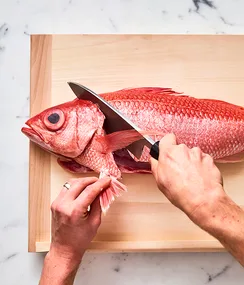Freshly cooked crab is always the way to go. It makes the most of the crab’s sweetness, feels more luxurious, and, even if it’s a little fiddly, the reward far outweighs the effort.
When it comes to choosing crab, pick one that’s both lively and heavy for its size, which will have the most meat. “Spanner crab in particular has a clean oceanic taste, and is much gentler in flavour than mud crab,” says Josh Niland of Sydney’s Saint Peter. “It has wonderful sweet meat that’s easy to work with.”
Niland recommends picking the crab and serving it with simple accoutrements: herbs such as dill, chervil or chives, a good helping of freshly made mayonnaise, perhaps flavoured with the crab’s head coral, and boats of witlof leaves for scooping.
What you need:
A large stockpot that will give you room to fit the crab and keep the water rapidly boiling.
A good sturdy chef’s knife is vital to cut through the crab
Seafood forks to easily pick out the meat.
Step 1
Add about 1kg of ice to a large bowl with 2 litres of water and 1/4 cup of salt, then add crab. Leave the crab in the ice until insensible (30 minutes), then check that it is limp and can be moved without response. If it is still lively, return it to the ice for another 10 minutes.

Step 2
Lift the tail flap and insert a knife under the shell, then push the knife towards the head and move it back and forth a few times to quickly kill the crab.

Step 3
To prepare cooking water, add 100gm fine cooking salt per 1 litre of water (a 1kg crab will need to be cooked in 7 litres of water) to a large stockpot. Bring to the boil, stirring to dissolve salt.
Step 4
Once water is boiling rapidly, add the crab. For every 100gm of crab, allow 1 minute of cooking time plus an additional 2 minutes. For example, a 1kg crab will need a total of 12 minutes cooking time. Once cooked, allow the crab to rest for 2 minutes before handling.
Step 5
Pull off the tail, then place a finger underneath the shell, pull up the “bonnet” firmly, then lift it away from the rest of the crab.

Step 6
Remove gills and clean around the meat. Remove the mouth or beak, and reserve the coral (head juices) separately to make a crab coral mayonnaise (see below).

Step 7
Remove the claws from the body and discard the swimmers (or save them for soup). Crack the claws with the back of your knife, then carefully remove the meat with a pick or seafood fork.

Step 8
Turn the crab body up on its side and cut through it laterally to expose the meat. Most crabs open from the middle, but this way, the meat will come out more easily. Pick the meat, then serve crab on its own, or with crab coral mayonnaise, scrambled eggs, or on white bread with the very best salted butter.
How to make crab coral mayonnaise
This mayonnaise complements the sweetness of the crab meat, best served with sides such as croûtons, witlof, celery and radishes.
Blend 2 large egg yolks with 2 tsp mustard and 25ml sherry vinegar (or lemon juice) in a small food processor to combine.
Gradually add 300ml grapeseed oil, a few drops at first, then in a thin, steady stream, blending continuously until emulsified.
Reduce crab coral on the stove until thick and glossy.
Add 50ml of the reduction to mayonnaise, then season with salt and add a little more sherry vinegar or lemon juice depending on your taste.
 Chris Chen
Chris Chen

